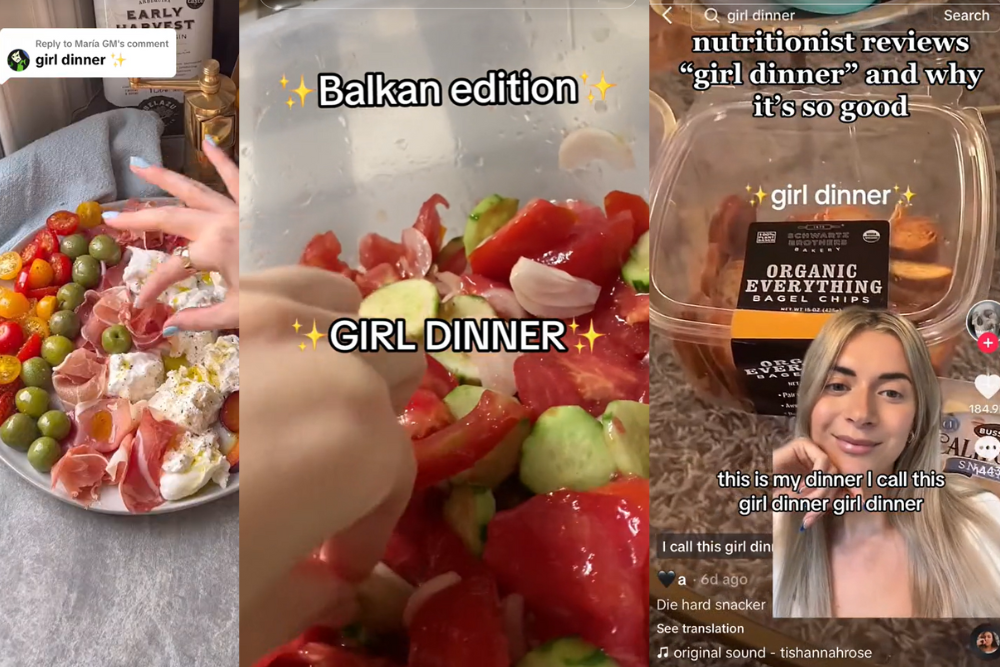TikTok’s ‘Girl Dinner’ Trend: An Examination of Its Health Impact
One of the latest social media fads to take the world by storm is TikTok’s ‘Girl Dinner’ trend. The trend involves users sharing videos of their simple, often snack-like meals, redefining the traditional concept of dinner.
It has quickly gained traction across the world, with over 200,000 tags and 500 million views on Tiktok. But is this trend promoting healthy eating, or is it potentially hazardous to health?
Understanding the ‘Girl Dinner’ Trend
The ‘Girl Dinner’ trend seems to embrace the adage ‘less is more’, turning away from intricate meal preparations towards simplicity and convenience.
A Girl Dinner can be viewed as a deconstructed meal or a reimagined dinner plate that echoes a charcuterie board. Typically, it includes an array of deli meats, various types of cheeses, an assortment of crackers, as well as a selection of freshly chopped fruits and vegetables.
A health perspective on this trend was provided by W, a Dietitian from Singapore, who goes by @thedietitianlabel on Instagram. They shared, “In general, for a healthy population, the trend is fine as long as it includes more nutrient-dense options. For instance, instead of ham, consider shaved meat. Opt for whole grains or rice crackers instead of regular crackers. Fresh fruits and cheeses are fine as well!” Even within the ‘Girl Dinner’ trend’s simplicity, meal diversity and balance remain crucial for optimal health.
@thedietitianlabel is a platform where W educates people about the importance of balanced nutrition and debunking popular myths around diet and food. Their approach is centred on personalising nutritional advice and promoting sustainable, healthy eating habits. They are known for their accessible and practical advice, often using popular food trends as a medium to impart their knowledge.
Conceptually, Girl Dinner stands in stark contrast to the prior popular trends of clean eating and labor-intensive home cooking from scratch. The primary appeal of these meals lies in their expediency, their convenience, and their suitability for those who prefer to nibble rather than indulge in larger, more structured meals.
Does the ‘Girl Dinner’ Trend Encourage Eating Disorders?
On a surface level, Girl Dinners seem innocuous. Nevertheless, some more extreme versions of the trend as seen on social media have ignited worries about the potential promotion of disordered eating.
In fact, under the banner of the Girl Dinner hashtag, some people are posting pictures of meals that are worryingly deficient in nutritional content and alarmingly low in calorie intake. These include simplistic dishes such as unadorned bowls of pasta, bare hamburger buns, large portions of popcorn, and even cans of sugary sodas.
When discussing disordered eating, it’s important to note that this term encompasses a wide range of abnormal eating behaviours.
While disordered eating may not qualify as a formal eating disorder, it can still harm physical health and emotional wellbeing. Chronic yo-yo dieting and frequent weight fluctuations are common examples. Others include an intense fear of weight gain and categorising food into “good” and “bad.”
The Girl Dinner trend might accidentally encourage these harmful behaviours. This can occur if it leads to habitual consumption of unbalanced meals. While seen as a flexible, quick, and easy alternative to traditional meal prep, over-reliance on such meals may lead to nutritional deficiencies. This could foster an unhealthy relationship with food.
It’s vital to approach this trend with a balanced perspective. The focus should remain on overall wellness and a diverse, nutritious diet.
Recognising the Signs of an Eating Disorder
Identifying signs of an eating disorder is key for intervention and recovery. These signs vary depending on the specific disorder, but some common indicators include:
Weight changes
Rapid weight loss, gain, or frequent fluctuations may be concealed by loose clothing.
Body obsession
Individuals may worry excessively about their body size, often negatively commenting on their appearance.
Eating habits
Unusual food rituals, eating only specific foods, or avoiding meals with others can signify a problem. Preoccupation with dieting or calorie counting is common.
Physical symptoms
Symptoms might include fatigue, feeling cold, irregular or absent periods (in females), dental issues, and slow wound healing.
Emotional changes
These can involve withdrawal from social interactions, increased mealtime anxiety, mood swings, and a fixation on food and cooking.
Excessive exercise
Overexertion in physical activity, even when injured or unwell, is often an attempt to burn calories.
Denial and secrecy
Individuals may deny having an issue and hide their eating behaviours.
Striking a Balance: Healthy ‘Girl Dinners’
It’s essential to remember that not all ‘Girl Dinners’ are created equal. A nutritionally balanced ‘Girl Dinner’ could include a good mix of protein, carbohydrates, and fibre, accompanied by a reasonable portion of fruits or vegetables.
Navigating the ‘Girl Dinner’ Waters
While the ‘Girl Dinner’ trend is all the rage, it’s crucial to consider your individual dietary needs and health objectives when jumping on this bandwagon.
It is the perfect opportunity to reimagine dinner, to explore new foods and flavours, and to introduce a fun, creative edge to meal times. However, it is essential not to lose sight of the importance of a well-rounded, nutritionally complete diet.
Remember, no trend should dictate your eating habits. Eat to nourish your body, to enjoy the experience, and to embrace the diverse world of food that surrounds you. After all, the goal isn’t to follow the trend, but to create a personal version of the ‘Girl Dinner’ that is unique, enjoyable, and above all, healthful.
Commenting on this, W from @thedietitianlabel shares guidance on creating a healthy ‘Girl Dinner’. “We always advocate for a meal that includes a variety of whole grains, dairy, fruits, vegetables, nuts, seeds, and high-quality protein.” They emphasise that our diets typically cover calories and protein, but sometimes fall short on micronutrients, such as vitamins and minerals.
They propose a practical solution: “Vary our diets to include fresh or minimally processed produce.” This practice aligns with the healthy eating guidelines and helps achieve high nutrient density. W’s insights can guide those wanting to make ‘Girl Dinners’ that are healthy, convenient, and tasty.
Digesting the Facts
The ‘Girl Dinner’ trend has taken TikTok by storm, changing how we perceive dinner and meal preparation. The simplicity and convenience of these meals can be appealing, especially to younger demographics.
While following food trends can be fun, it should not come at the cost of nutritional balance. The challenge and the opportunity lie in making the ‘Girl Dinner’ trend work for you and your unique dietary needs, ensuring your meals are not only trendy but also healthy.
References
- Eating disorders – Symptoms and causes. (2023, March 28). Mayo Clinic. https://www.mayoclinic.org/diseases-conditions/eating-disorders/symptoms-causes/syc-20353603













